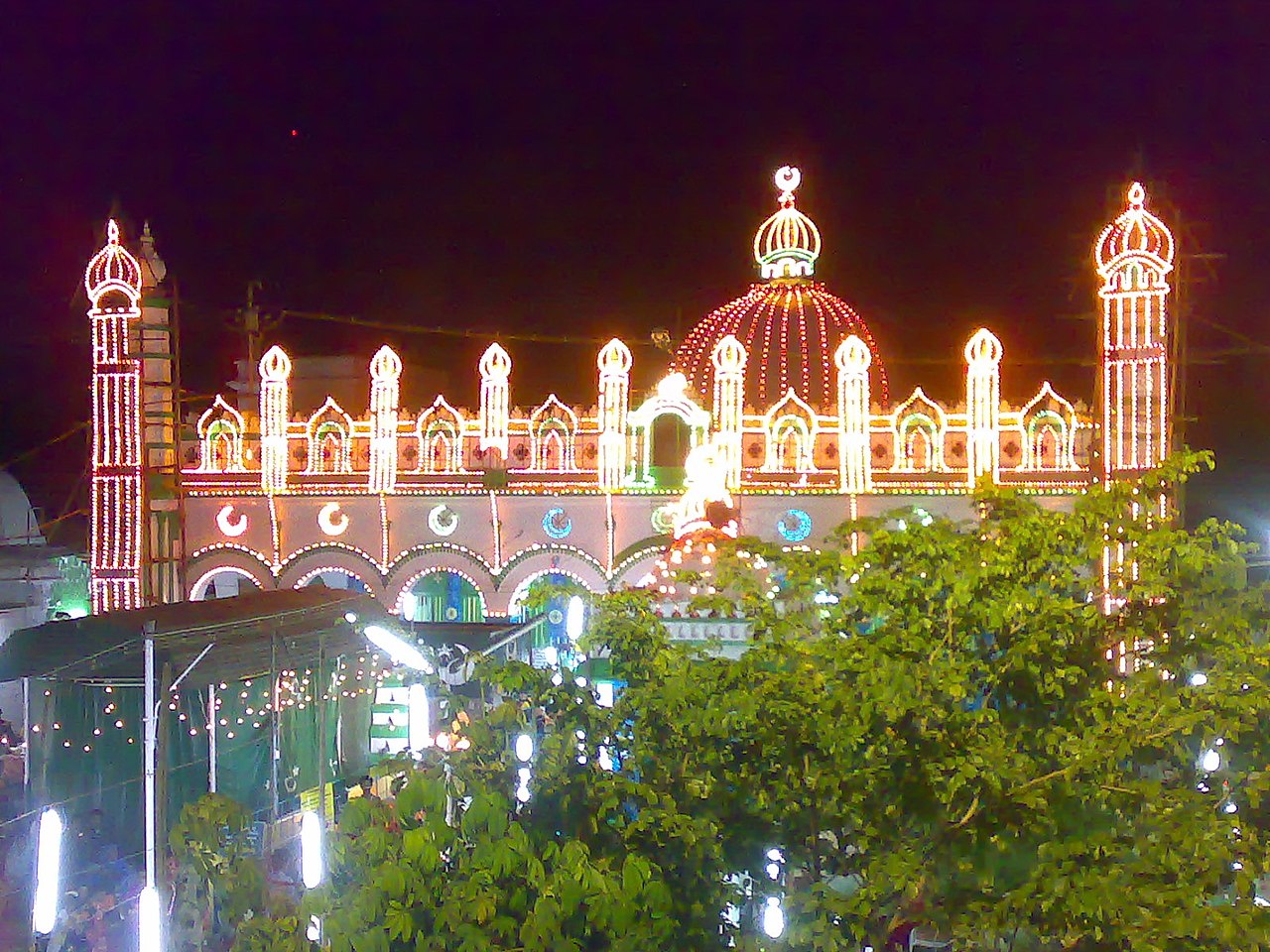
Masjid Gorippalayam Dargah
Goripalayam Dargah was built in 13th century and is the largest mosque in Madurai. The dargah encompasses graves of two Muslim saints and rulers of Madurai. The saints, Hazrat Sulthan Alauddin Badusha (Radiyallah) and Hazrat Sulthan Shamsuddin Badusha (Radiyallah), belonged to Oman. Located on the northern bank of the River Vaigai, it was believed to be built by Thirumalai Nayak. The remarkable feature about the dargah is that it has two tombs along with a dome. The size of the dome is 70 ft in diameter and 20 ft in height. The dome is made of a single piece of stone. The entrance of the dargah holds an inscription in Tamil language. This inscription is considered as an evidence of the existence of dargah since the 13th century.
Goripalayam Mosque is a large mosque in Goripalayam (part of Madurai City) containing two graves (tombs) of Sultans of Yemen, namely Khaja Syed Sultan Alauddin Badusha Razi and Khaja Syed Sulthan Shamsuddin of the Madurai Sultanate. There is also one invisible grave of Khaja Syed Sultan Habibuddin Razi, also known as Ghaibi Sulthan, who came to India to spread Islam. Its dome is 70 feet (21 m) in diameter and 20 feet (6.1 m) in height and made of a single block of stone brought from the Azhaga Hills. Thirumalai Nayak built it for his Muslim subjects. A beautiful green tomb can be seen from the A.V. Bridge, the Gorippalayam Dargah located on the northern banks of the Vaigai River. The name Gorippalayam comes from the Persian word for which means grave. This area is called Goripalayam because the graves of the two famous saints of Islam and rulers of Madurai Sulthan Alauddin Badusha (Radiyallah) and Sulthan Shamsuddin Badhusha (Radiyallah) are here. People from all over Tamil Nadu come here to seek blessings and go back fruitfully. The two rulers were brothers who ruled the northern part of Madurai after coming from Oman during the 13th century to spread Islam. They had heard about Qutb Sulthan Syed Ibrahim Shaheed Badusha of Erwadi, and his victory in south India, followed by the established Islamic rule in Madurai and Ramanathapuram provinces. Kazi Syed Tajuddin Radiyallah, the founder of Kazimar Big Mosque and who lived in Kazimar Street, was government Kazi (Islamic Legal advisor and jury) to the Sultans. Kazi Syed Tajuddin family members are still living in Kazimar Street and are maintaining the Kazimar Big mosque. From the time of Sultans, the Kazis to Madurai city are appointed from Kazi Syed Tajuddin, and this tradition was followed by the Pandiya Rulers, the Nayak Nawab rulers, and the British rulers. Even today, the post-independent democratic state government of Tamil Nadu appoints Kazi to Madurai only from the descendants of Kazi Syed Tajuddin, who was the Kazi to the Madurai Sultans. An ancient Tamil inscription can be found planted on the outer campus of the Maqbara of the dargah campus. The descendants of Sulthan Alauddin Badusha and Sulthan Shamsuddin Badusha (called as Sultans of Oman) purchased from the then King Koo(n) Pandiyan the land of Gorippalayam Dargah for a Feet of Gold piece and other six villages (namely Bibi Kulam, Chokkikulam, Cholikudi, Chirudoor, Kannanendal, Thiruppalai) at the rate of 14,000 Gold pieces for the maintenance of Gorippalayam Dargah. During the reign of King Veerappa Nanayakkara of the Madurai Nayak rulers, a dispute arose between the Huqdars of the Durgah and the employees of the Nayakkar Government regarding the six villages. The case was taken to King Veerappa Nayakkar, who inquired and verified the documents written by King Koo(n) Pandiyan and gave his verdict in the year 1573 A.D. as the Six villages and the Dargah land belongs to the Descendants of Sultans, and it should be in their enjoyment till the existence of Sun and Moon and who violates this will be liable for the sin of slaughtering a cow in the bank of river Ganga.

